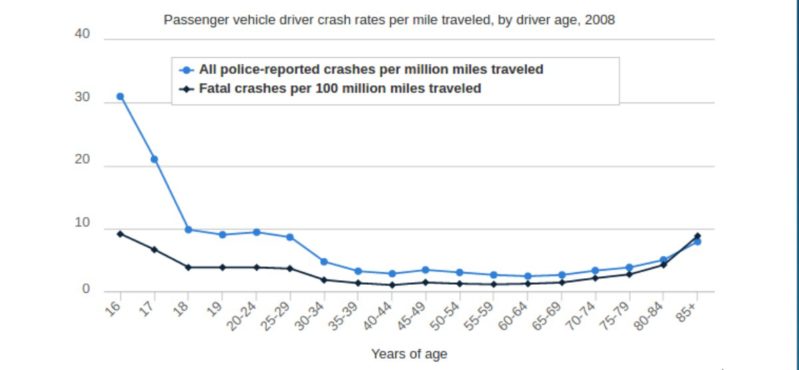
In the United States, we have a heavy driving culture. Millions of teenagers began driving throughout the country as soon as they’re eligible to take their driver tests, which is at 16 in most states, with the notable exception of New Jersey at 17. However, as is often the case when comparing actual practices to best practices, just because teens can legally drive from when they turn 16 doesn’t mean this is what’s best–neither for teens, nor for society. An analysis of the risk teen drivers pose to themselves and others, as well as comparisons of driving and licensing patterns in comparable countries around the globe, suggests the age for independent driving and licensing shouldn’t be 16, but 18. Let’s take a closer look at why together.
Teens are most likely to be involved in fatal collisions at 16
 The numbers are clear: 16-year-olds are more likely to be involved in collisions, fatal or otherwise, than drivers of any other age. Specifically, the IIHS chart above notes the rate of fatal crash involvement per 100 million miles traveled was 9.1 at 16, compared to 6.6 at 17 and 3.8 at 18. From 18, the rate of fatal crash involvement remained virtually constant between 3.6 and 3.8 until drivers reached the 30-34 age bracket, at which point the rate of fatal crash involvement dropped again to 1.8. I’ve written about teen crash involvement before, and while the risks are primarily related to male teens, this is a problem we need to tackle with all teenagers and all parents.
The numbers are clear: 16-year-olds are more likely to be involved in collisions, fatal or otherwise, than drivers of any other age. Specifically, the IIHS chart above notes the rate of fatal crash involvement per 100 million miles traveled was 9.1 at 16, compared to 6.6 at 17 and 3.8 at 18. From 18, the rate of fatal crash involvement remained virtually constant between 3.6 and 3.8 until drivers reached the 30-34 age bracket, at which point the rate of fatal crash involvement dropped again to 1.8. I’ve written about teen crash involvement before, and while the risks are primarily related to male teens, this is a problem we need to tackle with all teenagers and all parents.
This chart alone explains why teenagers shouldn’t drive alone at 16. Simply waiting a year cuts the risk of death by 27%, and waiting another year until 18 before independent driving cuts the risk by 58% compared to the risk of death faced by a 16-year-old driver. To put it another way, if 100 16-year-olds were involved in fatal crashes in their first (and final) year of driving, it’s likely that 42 of them would have survived their first year of driving had that cohort of 100 drivers begun driving at age 18 instead of at age 16.
If we simply delay our children’s independent driving by a couple of years, they effectively become as safe as drivers nearly a decade older. We need to give them the gift of time.
But doesn’t this just mean that 18 year olds have 2 years more driving experience than 16 year olds? What about new 18 year olds vs new 16 year olds?
It’s tempting to think that the only reason the driver death rates drop so dramatically between 16 and 18 is because all of the 18 year olds have the benefit of the 2 years of driving and hopefully not dying between 16 and 18. However, numerous studies have found this to be erroneous, whether in the US, Canada, or overseas.
A Canadian study found in 1992 that novice 16 year olds were more likely to be injured while driving than novice 17 or 18 year olds, with novice drivers defined as those with under a year of experience. A meta analysis of 11 studies since 1990 found the same results: 16 year old new drivers were more likely to crash than new older drivers.
It’s not about driving experience; it’s about cognitive development and life experience. Sixteen year olds simply aren’t as ready to drive as 18 year olds. Giving them lots of training before they turn 16 doesn’t change this, whether that training comes from parents or from driving instructors. This doesn’t mean that supervised driving time is meaningless for teenagers; it’s very valuable. However, it can’t overcome, statistically speaking, the increased risk of allowing unsupervised driving before 18. A 14-year old with 400 hours of supervised driving experience is still going to be a poorer driver than a 16-year old with 200 hours of supervised experience, because training time can’t overcome maturity when the maturity gap becomes too large. By the same measure, that 16-year old with 200 supervised hours will, statistically speaking, still be a much more dangerous driver than an 18-year old with 100 supervised hours.
Delaying licensing until 18 gives parents more time to drive with their teens
Besides the maturity that comes with having two additional years of life experience, a significant reason why teenagers are safer drivers at 18 than they are at 16 is because they have more experience behind the wheel. However, what we want is to give them supervised experience so they aren’t gaining experience while engaging in risky behavior (e.g., driving at night, driving with passengers, having minimal supervised hours, etc). To that end, when we require our teens to wait before obtaining their licenses, we can spend more time driving with them and modeling and monitoring safer driving tactics. We can take the time to choose safer vehicles for them rather than simply choosing the cheapest ones we can find because we feel pressured to reward them as soon as they turn 16.
Remember: teenagers driving in and of itself isn’t the problem; most teens manage to drive responsibly enough while under their learners’ permits or while taking their drivers’ tests to obtain licenses. The problem is that when teenagers drive on their own, there is a strong tendency for them to leave behind responsible driving habits and engage in risky behavior. The more time we spend driving with them, the more likely they are to internalize safe driving habits that they’ll be more likely to use when we don’t drive with them.
Sweden and Norway don’t license their teens until they turn 18
Finally, it’s worth considering the practices of countries with significantly safer driving cultures than those domestically. Sweden and Norway feature two of the lowest auto death rates on the planet per capita (at <3/100,000 people, compared to roughly 10-11/100,000 in the US), and both countries also feature the lowest rates of child auto fatalities on the globe. What do they do to keep their youngest drivers safe?
What can we take away from all of this?
Driving is a serious responsibility, not only for the driver but for every other citizen who may be impacted by the driver’s competence. In Sweden and Norway, where citizens are less likely to die from auto traffic than in any other wealthy country on the planet, no one drives a car before s/he turns 18. There’s just too much at stake. On the way to driving at 18, teens get lots of supervised practice, take lots of classes, and need to prove their competence in a number of ways. They take driving seriously there. Here, we lose approximately 2,600 13-19-year-olds each year. It doesn’t have to be this way. We can change the driving culture.
If you find the information on car safety, recommended car seats, and car seat reviews on this car seat blog helpful, you can shop through this Amazon link for any purchases, car seat-related or not. Canadians can shop through this link for Canadian purchases.

